
Yes are an English progressive rock band formed in London in 1968 by lead singer Jon Anderson, bassist Chris Squire, guitarist Peter Banks, keyboardist Tony Kaye, and drummer Bill Bruford. The band has undergone numerous lineup changes throughout their history, during which 20 musicians have been full-time members. Since February 2023, the band has consisted of guitarist Steve Howe, keyboardist Geoff Downes, bassist Billy Sherwood, singer Jon Davison, and drummer Jay Schellen. Yes have explored several musical styles over the years and are most notably regarded as progressive rock pioneers.
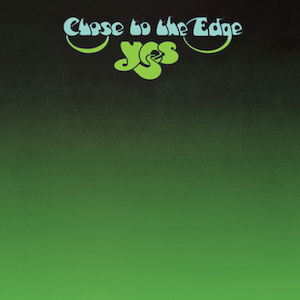
Close to the Edge is the fifth studio album by English progressive rock band Yes. It was released on 8 September 1972 by Atlantic Records, and is their last album of the 1970s to feature their original drummer Bill Bruford. After scoring a commercial and critical hit with Fragile and touring the album, Yes regrouped to prepare material for a follow-up, ideas for which had been put down some months before. The album's centrepiece is the 18-minute title track, with themes and lyrics inspired by the Herman Hesse novel Siddhartha. Side two contains two non-conceptual tracks, the folk-inspired "And You and I" and the comparatively straightforward rocker "Siberian Khatru". Bruford found the album particularly laborious to make, which culminated in his decision to quit the band after it was recorded to join fellow English progressive rock band King Crimson.

Tales from Topographic Oceans is the sixth studio album by English progressive rock band Yes, released on 7 December 1973 by Atlantic Records. It is their first studio album to feature drummer Alan White, who had replaced Bill Bruford the previous year. Frontman Jon Anderson devised its concept during the Close to the Edge Tour, when he read a footnote in Autobiography of a Yogi by Paramahansa Yogananda that describes four bodies of Hindu texts about a specific field of knowledge, collectively named shastras–śruti, smriti, puranas, and tantras. After pitching the idea to guitarist Steve Howe, the pair spent the rest of the tour developing an outline of the album's musical themes and lyrics.
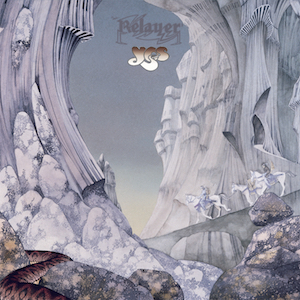
Relayer is the seventh studio album by the English progressive rock band Yes, released in November 1974 by Atlantic Records. After keyboardist Rick Wakeman left the group in May 1974 over disagreements with the band's direction following their double concept album Tales from Topographic Oceans (1973), Yes entered rehearsals as a four-piece in Buckinghamshire. They auditioned several musicians, including Greek keyboardist and composer Vangelis, before settling with Swiss musician Patrick Moraz of Refugee who incorporated elements of funk and jazz fusion to the album. Relayer is formed of three tracks, with "The Gates of Delirium" on side one and "Sound Chaser" and "To Be Over" on side two.

Union is the thirteenth studio album by English progressive rock band Yes, released on 30 April 1991 by Arista Records. Production began following the amalgamation of two bands that featured previous and then-current members of Yes: Anderson Bruford Wakeman Howe (ABWH), consisting of vocalist Jon Anderson, drummer Bill Bruford, keyboardist Rick Wakeman and guitarist Steve Howe, and Yes, comprised at that time of bassist and vocalist Chris Squire, guitarist and vocalist Trevor Rabin, keyboardist Tony Kaye and drummer Alan White. The eight musicians signed with Arista and a combination of unfinished tracks by both groups were selected for Union. The album's sessions were problematic from the start, including disagreements between some of the musicians regarding the "merger" of the two bands, strained relations during the recording process, and decisions by the production team of Anderson and producer Jonathan Elias to bring in session musicians to re-record parts that Wakeman and Howe had originally completed.
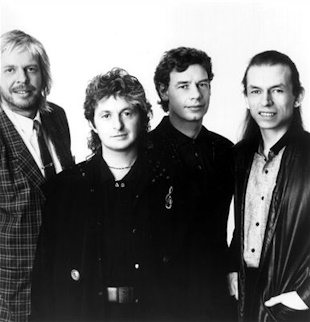
Anderson Bruford Wakeman Howe (ABWH) were an English progressive rock band active from 1988 to 1990 that comprised four past members of the English progressive rock band Yes. Singer Jon Anderson left Yes as he felt increasingly constrained by their commercial and pop-oriented direction in the 1980s. He began an album with other members from the band's 1970s era: guitarist Steve Howe, keyboardist Rick Wakeman, and drummer Bill Bruford, plus bassist Tony Levin.

Going for the One is the eighth studio album by English progressive rock band Yes, released on 15 July 1977 by Atlantic Records. After taking a break in activity in 1975 for each member to release a solo album, and their 1976 tour of the United States and Canada, the band relocated to Montreux, Switzerland to record their next studio album. During rehearsals, keyboardist Patrick Moraz left the group, which marked the return of Rick Wakeman who had left to pursue a solo career after differences surrounding Tales from Topographic Oceans (1973). In a departure from their previous albums, Going for the One, with the exception of the fifteen-minute "Awaken", features shorter and more direct songs without an overarching concept, and saw Yes record with new engineering personnel and cover artists.

Drama is the tenth studio album by the English progressive rock band Yes, released on 18 August 1980 by Atlantic Records. It was their only album to feature Trevor Horn on lead vocals and the first with Geoff Downes on keyboards. This followed the departures of Jon Anderson and Rick Wakeman after attempts to record a new album in Paris and London had failed. Drama was recorded hurriedly with Horn and Downes, as a tour had already been booked before the change in personnel. The album marked a development in Yes' musical direction, combining the band's progressive signature with Horn and Downes' new wave sensibilities.
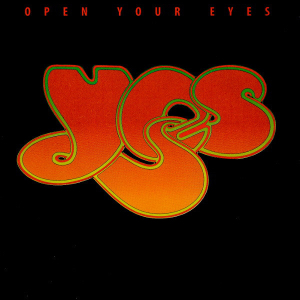
Open Your Eyes is the seventeenth studio album by the English rock band Yes, released in November 1997 by Eagle Records in the UK and by Beyond Music in the US. Following the 1996 revival of the 1970s "classic" line-up of Yes, the band's relationship with management had broken down and keyboardist Rick Wakeman had once again left the band. While various other members dispersed, guitarist, keyboardist, and producer Billy Sherwood began developing new songs with band bassist and de facto leader Chris Squire to prevent the band from losing momentum and fully splitting. Yes' new management company suggested adding a couple of songs originally written for Squire and Sherwood's other band Conspiracy to help build up material for a new Yes studio album. With the writing and production sessions dominated by Squire and Sherwood, and with singer Jon Anderson, guitarist Steve Howe and drummer Alan White only involved later in the process, the writing and creative input of the latter three members was limited.
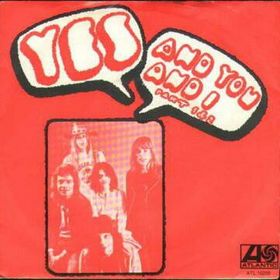
"And You and I" is the second track from the album Close to the Edge by the English progressive rock band Yes. The song is just over ten minutes in length and consists of four movements. The first and second parts of the song were released as a single edit and reached number 42 on the Billboard Hot 100.
"Siberian Khatru" is the third song on the album Close to the Edge by English progressive rock band Yes. Live versions of the song are included on the albums Yessongs, Keys to Ascension, Live at Montreux 2003 and In the Present – Live from Lyon. Multiple performances of the song are included on the 2015 boxed-set Progeny: Seven Shows from Seventy-Two, which features seven complete consecutive concerts recorded on the band's late 1972 North American tour.

Fragile is the fourth studio album by the English progressive rock band Yes, released on 12 November 1971 by Atlantic Records. It was the band's first album to feature keyboardist Rick Wakeman, who replaced Tony Kaye after the group had finished touring their breakthrough record, The Yes Album (1971).

"Roundabout" is a song by the English progressive rock band Yes from their fourth studio album Fragile, released in November 1971. It was written by singer Jon Anderson and guitarist Steve Howe and produced by the band and Eddy Offord. The song originated when the band were on tour and travelled from Aberdeen to Glasgow, and went through many roundabouts on the way.

"I've Seen All Good People" is a song by the English progressive rock band Yes, written by frontman Jon Anderson and bassist Chris Squire and recorded on their third studio album, The Yes Album (1971). The almost 7-minute song is in two parts; the first, titled "Your Move", was released as a single in 1971 which peaked at number 40 in the US, which helped the group build momentum. The second part is entitled "All Good People".
"South Side of the Sky" is a song by progressive rock band Yes from their album Fragile.

Fly from Here is the twentieth studio album by the English progressive rock band Yes. It was released on 22 June 2011 by Frontiers Records, and is their only album featuring lead vocalist Benoît David and keyboardist Oliver Wakeman. Yes reformed in 2008 after a four-year hiatus with a line-up of David, Wakeman, bassist Chris Squire, guitarist Steve Howe, and drummer Alan White. The band prepared material to record for Fly from Here during breaks in touring in 2010 and 2011, during which they enlisted former Yes frontman Trevor Horn as producer. After songs contributed by Wakeman were scrapped in favour of expanding the song "We Can Fly" into a 24-minute six-part "Fly from Here" suite, the band replaced him with former Yes keyboardist Geoff Downes as he co-wrote much of the new material.

Yessongs is a concert film by the English progressive rock band Yes. It was recorded at the Rainbow Theatre, London on 15 and 16 December 1972 during the band's Close to the Edge Tour, and features the line-up of Jon Anderson, Chris Squire, Steve Howe, Rick Wakeman, and Alan White. The video was produced by David Speechley, directed by Peter Neal, and co-edited by Howe's brother Philip. The film was arranged at short notice, which affected the quality of filming as a result, and originally a private memento for the band to document their two performances at the Rainbow before they agreed for its theatrical release.

"Wonderous Stories" is a song by the English progressive rock band Yes, released in September 1977 as the first single from their eighth studio album, Going for the One. It was written by lead vocalist Jon Anderson, who gained inspiration for the song one morning during his stay in Montreux, Switzerland where the band recorded the album. The song reached number 7 on the UK Singles Chart and remains the band's highest-charting single in the country.
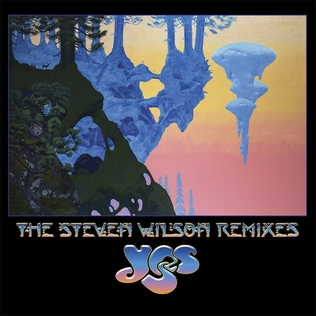
The Steven Wilson Remixes is a box set by the English progressive rock band Yes. Released on 29 June 2018, it compiles remixed versions of five of the band's albums—The Yes Album (1971), Fragile (1971), Close to the Edge (1972), Tales from Topographic Oceans (1973), and Relayer (1974)—overseen by Steven Wilson.

















